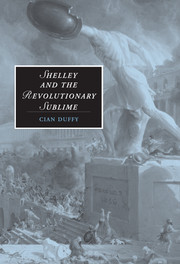Book contents
- Frontmatter
- Contents
- Acknowledgements
- Note on texts
- List of abbreviations
- Introduction: Approaching the ‘Shelleyan sublime’
- 1 From religion to revolution, 1810–1813
- 2 Cultivating the imagination, 1813–1815
- 3 Mont Blanc and the Alps, 1816
- 4 Writing the revolution: Laon and Cythna (1817)
- 5 ‘Choose reform or civil war’, 1818–1819
- Conclusion: ‘Good and the means of good’, 1822
- Notes
- Bibliography
- Index
- CAMBRIDGE STUDIES IN ROMANTICISM
4 - Writing the revolution: Laon and Cythna (1817)
Published online by Cambridge University Press: 15 December 2009
- Frontmatter
- Contents
- Acknowledgements
- Note on texts
- List of abbreviations
- Introduction: Approaching the ‘Shelleyan sublime’
- 1 From religion to revolution, 1810–1813
- 2 Cultivating the imagination, 1813–1815
- 3 Mont Blanc and the Alps, 1816
- 4 Writing the revolution: Laon and Cythna (1817)
- 5 ‘Choose reform or civil war’, 1818–1819
- Conclusion: ‘Good and the means of good’, 1822
- Notes
- Bibliography
- Index
- CAMBRIDGE STUDIES IN ROMANTICISM
Summary
Shelley, Mary, and Claire left Geneva at nine in the morning on 29 August 1816, and headed back towards England on a ‘shorter route’ which avoided Paris, passing instead through Fontainebleu and Versailles (MWSJ, p. 132; Letters, i, p. 504). Having stopped at Fontainebleu en route, they arrived at Versailles just after nine in the evening on 2 September (MWSJ, p. 132). The following morning, they visited the ‘famous palace’ itself (Letters, i, p. 154).
Shelley recorded this visit in Mary's journal. His account stresses the ‘stupid … expense’ involved in constructing the palace, noting moreover that there was ‘something effeminate and royal’ in the décor (MWSJ, p. 133). He immediately contrasts this ‘royal’ effeminacy with the classical, republican virtue that he had recently invoked in response to Chamonix's fideist tourist industry. ‘Could a Grecian architect have commanded all the labours and money which was expended on Versailles’, he observes, ‘he would have produced a fabric such as the whole world has never equalled’ (MWSJ, p. 133). Shelley goes on to explain the bloody course of the French Revolution in terms of the resentment bred in the people by the impact and exhibition of such ‘stupid … expense’, echoing his 1812 strictures on the prince regent's fête at Carlton House. ‘The present desolation of France’, he affirms, ‘the fury of the injured people, and all the horrors to which they abandoned themselves … flowed naturally enough from expenditures so immense’ (MWSJ, p. 133–4).
- Type
- Chapter
- Information
- Shelley and the Revolutionary Sublime , pp. 123 - 148Publisher: Cambridge University PressPrint publication year: 2005



